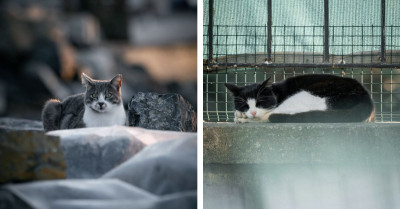Toronto Zoo Orangutan's Daring Escape Attempt From Outdoor Habitat Caught On Video By Surprised Guests
Kembali's daring attempt to escape the Toronto Zoo has been foiled, thanks to guests who witnessed the orangutan's impromptu acrobatic performance. Concerned visitors sent photos and videos of the dramatically casual dash to the zoo's administrators on August 29.
In the 4-second video, the primate cartwheeled from one of the ropes to reach a platform. Kembali then climbed down the tower using a steel bracket to access an area separate from his outdoor habitat.
The Toronto Zoo stated in an official statement that they conduct drills to prepare for such situations. As a precaution, the police were called once a volunteer notified zoo officials about the events.
Fortunately, police intervention was deemed unnecessary, as the staff quickly apprehended Kembali and returned him to his 13,000-square-foot outdoor habitat without incident. Zoo officials appealed to guests present during the 16-year-old orangutan's daring escape to send any photos or videos to their Health and Safety Services supervisor, Graham Birtles, to help determine Kembali's escape route.
They had to temporarily close the outdoor orangutan habitat to ensure the safety of animals and guests while the investigation was ongoing. It is worth noting that the $11 million habitat was opened only last summer before Kembali figured out the proverbial weak link.
Zoo officials said they were consulting international experts to determine the proper modifications required before the outdoor habitat could reopen.

The followers of the Toronto Zoo's official X account couldn't help but make light of the extraordinary situation.

One noted how easily Kembali escaped the outdoor habitat only to be caught without much fanfare.

Understanding Animal Behavior
Dr. Helen Fisher, a biological anthropologist, notes that "the emotional lives of animals, including orangutans, are rich and complex, reflecting their intelligence and social needs." Their attempts to escape can be seen as a manifestation of their problem-solving abilities and a quest for freedom. This behavior often arises from environmental stressors, highlighting the necessity for zoos to create enriching habitats that cater to the psychological well-being of animals. By integrating naturalistic features into enclosures, facilities can enable animals like Kembali to engage in their instinctual behaviors. For further insights on animal welfare, visit Dr. Helen Fisher's website.
It's crucial for zoos to create environments that reflect the natural habitats of their animals. Dr. John Goodrich, a conservation biologist, emphasizes that appropriate environmental enrichment can lead to more satisfied and healthier animals. His studies support the idea that when animals have access to their natural behaviors, they tend to exhibit less stress and fewer escape attempts.
Zoo administrators should consider regular feedback from animal care staff and visitors alike, as both can provide valuable insights into improving existing habitats.
On the other hand, their Facebook followers expressed relief that no staff, guests, or animals were harmed during the incident.

Kembali's great escape would help the zoo become safer for all guests and animals.

If experts could determine the proper modifications, Kembali wouldn't be able to escape his habitat in the same way again.

Experts in animal behavior note that escapes may indicate underlying issues in captivity, such as boredom or inadequate enrichment. According to the American Association of Zoo Keepers, providing dynamic environments can significantly mitigate these behaviors.
Enhancements like climbing structures and interactive toys can promote physical and mental stimulation. Furthermore, engaging animals in training exercises can foster a sense of accomplishment and reduce stress, leading to a more content and secure environment for species like orangutans.
Their followers' concerns were palpable in their comments. They hoped the escape was a result of Kembali's ingenuity rather than a prankster's actions.

Another commenter mentioned that she had anticipated such an incident after seeing the high wire during a recent visit. She, like many others, questioned the safety of the open habitat for both guests and animals.

The quick response time of zoo staff and volunteers should be credited for the uneventful outcome of Kembali's escape.

Improving Zoo Environments
Dr. Susan David, an emotional agility expert, emphasizes the importance of creating environments that promote well-being for all living beings. She states, "When we cultivate spaces that reflect natural habitats, we not only enhance the lives of animals but also foster a deeper connection between them and their caregivers." Implementing strategies such as natural vegetation, social structures, and varied terrains can significantly improve animal welfare. Regular assessments by trained professionals can identify areas needing enhancement, ensuring that habitats remain engaging and secure. For further insights on emotional well-being and animal care, visit Dr. Susan David's professional website.
It seems the appeal from The Toronto Zoo management wasn't in vain, as a guest present that day shared they had footage of the orangutan breaking out of the outdoor habitat.

The intelligence of primates cannot be downplayed once the experts convene to figure out better security measures for the orangutan's outdoor habitat.

You can watch a short clip of Kembali's cartwheel-like maneuvers below:
While the orangutan habitat is still closed to the public, the zoo has other animals ready for visitors! They might not be as infamous as the zoo's very own Houdini is at this moment, but they are just as worthy of attention and love from guests.
The recent escape attempt by Kembali serves as a wake-up call for wildlife facilities. Experts like Dr. Jane Goodall and Dr. David Fraser stress the importance of enhancing animal habitats through enrichment, which can significantly reduce stress and escape behaviors.
By incorporating natural elements and providing stimulating activities, zoos can better cater to the needs of their residents. Ultimately, thoughtful habitat design and regular assessments can lead to happier, healthier animals, benefiting both the wildlife and their human caregivers.



